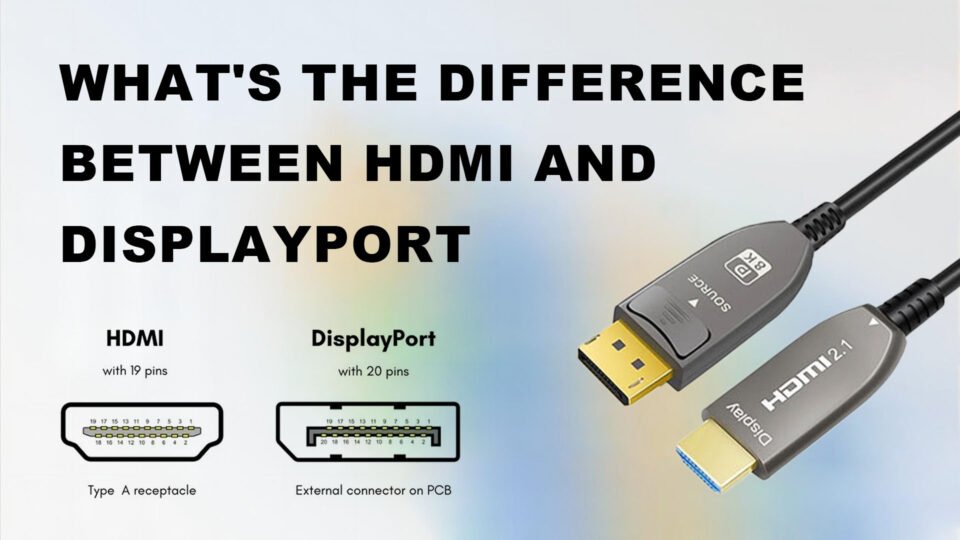The 8K UHD industry has immense growth potential. As technology evolves, hardware costs for 8K cameras, drones, TVs, GPUs, monitors, and projectors will drop, making them more accessible. The popularity of VLOGs and live streaming will drive 8K content creation, fostering a content-device growth cycle. Video transmission interfaces play a crucial role in determining the quality, efficiency, and versatility of multimedia experiences. HDMI, DisplayPort, and USB-C are the three dominant standards, each with its own advantages and limitations. However, with its multifunctional capabilities, USB-C is emerging as the future trend, particularly in mobile and portable devices.

| Interface | Features | Economic Costs | Popularity | Pros & Cons |
| HDMI | -Supports up to HDMI 2.1 (8K@60Hz, 4K@144Hz) -eARC supports high-quality audio | -Low production cost -Moderate wire cost -Highest patent fee | – TVs, projectors, game consoles, media converters and home audio-visual equipment are widely used | ✅ Suitable for home entertainment, gaming, and commercial display ✅ Strong compatibility, widely used in consumer electronics ❌ Lower bandwidth than DP (maximum 48Gbps) |
| DisplayPort (DP) | -Supports up to DP 2.1 (16K@60Hz, 8K@240Hz) -DSC lossless compression technology | -High production cost -High wire cost -No patent fee | – Widely used in professional monitors, PCs, workstations, media converters and gaming equipment | ✅ Highest bandwidth (up to 80Gbps), suitable for high-end display ✅ Multi-stream transmission (MST) can expand multiple screens ❌ The penetration rate of consumer electronics is low, mainly used for PC and professional display |
| USB-C (Alt Mode) | -Support 8K@60Hz via DP Alt Mode -Transmit video, data and power at the same time | -High production cost -High wire cost -Moderate patent fee | – Thin and light laptops, mobile phones, tablets, VR devices, conference cameras, video bars and other emerging devices | ✅ One-line multi-purpose, suitable for mobile devices ✅ Small size, suitable for thin and light devices ❌ Depends on device compatibility, bandwidth is not as good as DP 2.1 |
Comparison of HDMI, DisplayPort, USB-C
HDMI:
Suitable for the consumer electronics market (TV, game consoles, audio and video equipment), with the highest penetration rate, low cost but relatively low bandwidth.
DisplayPort:
Suitable for professional display, e-sports and workstations, with large bandwidth, but low penetration in consumer electronics.
USB-C (Alt Mode):
Suitable for thin and light notebooks and mobile devices, with one line for multiple uses, but limited bandwidth, and device compatibility needs to be considered.
However, HDMI‘s patent licensing fees are high, which is one of the important factors limiting its development in some markets. In contrast, DisplayPort is managed by VESA (Video Electronics Standards Association) and is free of licensing fees, which makes many PC manufacturers and professional display devices prefer DP. USB-C (DP Alt Mode) relies on the open standard USB protocol, and the licensing cost is relatively low, so it has grown rapidly in the field of mobile devices and notebooks.
Remark: The terms HDMI, HDMI High-Definition Multimedia Interface, HDMI Trade Dress and the HDMI Logos are trademarks or registered trademarks of HDMI Licensing Administrator, Inc.
Impact of HDMI’s Licensing Fee
Cost pressure:
Manufacturers must pay a fixed fee to the HDMI Association + a commission based on sales, resulting in higher prices for end products.
Restricted innovation:
Some manufacturers may choose other standards due to patent fees, especially in the PC industry.
Market competition:
DisplayPort and USB-C have more opportunities for adoption in high-end display, e-sports, mobile devices and other fields.
Forecast of Future Trends:
Home entertainment is still dominated by HDMI, but if the licensing fee is not reduced, it may gradually be replaced by DisplayPort or USB-C in high-performance fields such as PC, VR, e-sports and some commercial applicatons such as HD conferencing, 4K Cameras, Video bars.
DisplayPort is expanding in the high-end market, especially in 8K and future 16K display needs, with obvious bandwidth advantages.
USB-C will continue to grow, relying on DP Alt Mode and Thunderbolt technology, becoming the first choice for future thin and light devices and portable displays.
Possible changes:
If the HDMI Association reduces patent fees or further optimizes the HDMI 2.1+ standard (such as increasing bandwidth and enhancing compression technology), it may still maintain its market dominance. Otherwise, high-bandwidth, low-cost DisplayPort and USB-C may gradually erode the HDMI market in the future.
Why is full-featured USB-C becoming more and more popular?
Full-featured USB-C, especially full-featured 8K Fiber Optic USB-C AOC has rapidly spread in PC, tablets, mobile phones, monitors, VR/AR, PTZ Cams, Video Bars and other fields with its advantages of high-bandwidth video, data transmission and power supply, becoming one of the future trends.
Core factors for the popularity of USB-C:
One line for multiple uses: supports 8K@60Hz video output (DP Alt Mode), 10Gbps data transmission (USB 3.2+), and up to 100W power supply (PD protocol), which greatly simplifies the device interface.
Cost advantage: Compared with HDMI, which requires high licensing fees, USB-C has lower costs for open standards and manufacturers are more willing to adopt it.
Thinning trend: The demand for thin and light design of notebooks, tablets, mobile phones and other devices has increased, and the compact size of USB-C is more suitable for modern devices.
Ecosystem development: More and more peripherals such as monitors, docking stations, storage devices, etc. are beginning to support USB-C, enhancing compatibility.
Future technology evolution: USB4 further integrates Thunderbolt 3/4, supports higher bandwidth and wider compatibility, making the advantages of USB-C more obvious.

5m USB3.2 Gen2 Fiber Optic USB-C AOC
Customized length up to 15m
Possible challenges of USB-C:
The video bandwidth is still lower than DisplayPort 2.1 (maximum 80Gbps vs. 40Gbps of USB4).
Device compatibility is complex, and different manufacturers have different levels of support for USB-C cables and protocols, which requires consumers to carefully select compatible cables and devices.
At present, HDMI/DP has not been completely replaced, especially in the field of high-end e-sports and professional display, HDMI 2.1 and DP 2.1 are still more powerful.
Future trends:
As USB4 and Thunderbolt 5 further increase bandwidth, USB-C will become more and more important in high-end display, VR/AR, and thin and light devices, and may even become the mainstream interface for notebooks and mobile devices, while HDMI and DP may be more used in home entertainment, e-sports, professional display and other fields.
Which Is the Future Trend?
While HDMI will continue to dominate home entertainment and DisplayPort will serve high-end displays, USB-C is positioned as the most versatile and future-proof interface. Its ability to replace multiple ports, support mobile and desktop devices, and integrate with emerging technologies like USB4 and Thunderbolt 5 makes it the strongest candidate for the next-generation connectivity standard.
Conclusion: If you’re looking for a universal, future-proof interface, USB-C is the answer.






